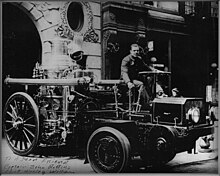
Tatra is a Czech vehicle manufacturer from Kopřivnice. It is owned by the TATRA TRUCKS a.s. company, and it is the third oldest company in the world producing motor vehicles with an unbroken history. The company was founded in 1850 as Ignatz Schustala & Cie. In 1890 the company became a joint-stock company and was renamed the Nesselsdorfer Wagenbau-Fabriksgesellschaft. In 1897, the Nesselsdorfer Wagenbau-Fabriksgesellschaft produced the Präsident, which was the first factory-produced automobile with a petrol engine to be made in Central and Eastern Europe. In 1918, the company was renamed Kopřivnická vozovka a.s., and in 1919 it changed from the Nesselsdorfer marque to the Tatra badge, named after the nearby Tatra Mountains on the Czechoslovak-Polish border.

Mack Trucks, Inc. is an American truck manufacturing company and a former manufacturer of buses and trolley buses. Founded in 1900 as the Mack Brothers Company, it manufactured its first truck in 1905 and adopted its present name in 1922. Mack Trucks is a subsidiary of AB Volvo, which purchased Mack along with its then parent company Renault Véhicules Industriels in 2000.

The Peerless Motor Car Company was an American automobile manufacturer that produced the Peerless brand of motorcars in Cleveland, Ohio, from 1900 to 1931. One of the "Three Ps" – Packard, Peerless, and Pierce-Arrow – the company was known for building high-quality luxury automobiles. Peerless popularized a number of vehicle innovations that later became standard equipment, including drum brakes and the first enclosed-body production cars.

The Knox Automobile Company was a manufacturer of automobiles in Springfield, Massachusetts, United States, between 1900 and 1914. Knox also built trucks and farm tractors until 1924. They are notable for building the very first modern fire engine in 1905, and the first American vehicle with hydraulic brakes, in 1915.

Thornycroft was an English vehicle manufacturer which built coaches, buses, and trucks from 1896 until 1977.
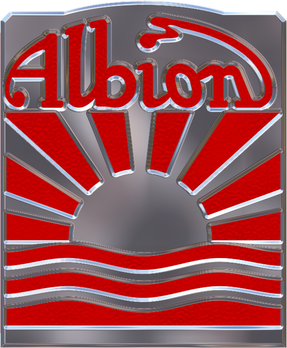
Albion Motors was a Scottish automobile and commercial vehicle manufacturer.

The Vulcan Motor and Engineering Company Limited, of Southport, England, made cars from 1902 until 1928 and commercial vehicles from 1914 until 1953.

Guy Motors was a Wolverhampton-based vehicle manufacturer that produced cars, lorries, buses and trolleybuses. The company was founded by Sydney S. Guy (1885–1971) who was born in Kings Heath, Birmingham. Guy Motors operated out of its Fallings Park factory from 1914 to 1982, playing an important role in the development of the British motor industry.
The Marmon-Herrington Company, Inc. is an American manufacturer of axles and transfer cases for trucks and other vehicles. Earlier, the company built military vehicles and some tanks during World War II, and until the late 1950s or early 1960s was a manufacturer of trucks and trolley buses. Marmon-Herrington had a partnership with Ford Motor Company, producing trucks and other commercial vehicles, such as buses. The company may be best known for its all-wheel-drive conversions to other truck maker's units, especially to Ford truck models. Founded in 1931, Marmon-Herrington was based in Indianapolis, Indiana, with a plant in Windsor, Ontario, and remained in Indianapolis until 1963. It is now based in Louisville, Kentucky.

The Diamond T Company was an American automobile and truck manufacturer. They produced commercial and military trucks.
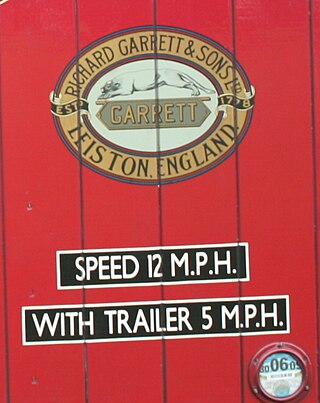
Richard Garrett & Sons was a manufacturer of agricultural machinery, steam engines and trolleybuses. Their factory was Leiston Works, in Leiston, Suffolk, England. The company was founded by Richard Garrett in 1778.
The SA was Toyota's first new passenger car design after World War II. It was the first in a family of vehicles before the introduction of the Crown. A series of light trucks also shared the chassis and major components of these passenger cars.

Schacht was an American marque of automobiles and High-wheelers from 1904 to 1913, in Cincinnati, Ohio. The Schacht Manufacturing Company, later renamed Schacht Motor Car Company produced over 9,000 automobiles. The company was reorganized as the G.A. Schacht Motor Truck Company in 1914 and production of trucks and fire trucks continued until 1938.

Straker-Squire was a British automobile manufacturer based in Bristol, and later Edmonton in North London.

The Maudslay Motor Company was a British vehicle maker based in Coventry. It was founded in 1901 and continued until 1948 when it was taken over by the Associated Equipment Company (AEC) and along with Crossley Motors the new group was renamed Associated Commercial Vehicles (ACV) Ltd.
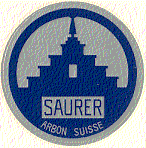
Adolph Saurer AG was a Swiss manufacturer of embroidery and textile machines, trucks and buses under the Saurer and Berna brand names. Based in Arbon, Switzerland, the firm was active between 1903 and 1982. Their vehicles were widely used across mainland Europe, particularly in the interwar period.

The Jackson Automobile Company was an American Brass Era automobile manufacturer located in and named for Jackson, Michigan. The company produced the Jackson from 1903 to 1923, the 1903 Jaxon steam car and the 1904 Orlo.

The Class-B Standardized Military Truck or "Liberty Truck" was a heavy-duty truck produced by the United States Army during World War I. It was designed by the Quartermaster Corps with help from the Society of Automotive Engineers in 1910 in an effort to help standardize the immense parts catalogue and multiple types of vehicles then in use by the US military, as well as create a truck which possessed all the best features of heavy truck technology then available. It was the first official standardized motor vehicle adopted and produced by the US Military.
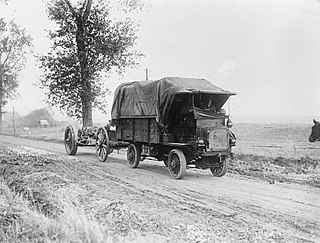
The FWD Model B was an American built four-wheel drive truck produced by the Four Wheel Drive Auto Company that saw widespread service with American and British forces during the First World War.

The Mack AC was a heavy cargo truck designed in the 1910s by the American manufacturer Mack Trucks. Introduced in 1916, the Mack AC saw extensive service during the First World War with the British and American armed forces, in British service it was given the nickname the "Bulldog" which led to Mack adopting the Bulldog as its corporate symbol.
